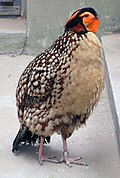| Tragopan | |
|---|---|

| |
| Blyth's tragopan (Tragopan blythii) | |
| Scientific classification | |
| Domain: | Eukaryota |
| Kingdom: | Animalia |
| Phylum: | Chordata |
| Class: | Aves |
| Order: | Galliformes |
| Family: | Phasianidae |
| Tribe: | Lophophorini |
| Genus: | Tragopan Cuvier, 1829 |
| Type species | |
| Meleagris satyra (satyr tragopan) Linnaeus, 1758
| |
Tragopan is a bird genus in the pheasant family Phasianidae. Member of the genus are commonly called "horned pheasants" because males have two brightly colored, fleshy horns on their head that can be erected during courtship displays. The habit of tragopans to nest in trees is unique among phasianids.[1]
Taxonomy
[edit]The genus Tragopan was introduced by the French naturalist Georges Cuvier in 1829 for the satyr tragopan.[2] The name tragopan is a mythical horned purple-headed bird mentioned by the Roman authors Pliny and Pomponius Mela.[3]
The genus contains five species.[4]
| Image | Name | Common name | Distribution |
|---|---|---|---|
 |
Tragopan melanocephalus | Western tragopan | Kohistan, Kaghan valley, Kishtwar, Chamba, Kullu and an area east of the Satluj river, Pakistan |
 |
Tragopan satyra | Satyr tragopan | India, Tibet, Nepal and Bhutan. |
 |
Tragopan temminckii | Temminck's tragopan | northern Myanmar to northwestern Tonkin. |
 |
Tragopan blythii | Blyth's tragopan | Bhutan through northeast India, north Myanmar to southeast Tibet, and also China. |
 |
Tragopan caboti | Cabot's tragopan | provinces of Fujian, Jiangxi, Zhejiang, and Guangdong, China |
References
[edit]- ^ Madge, S.; McGowan, P. (2002). "Genus Tragopan: tragopans (horned pheasants)". Pheasants, partridges and grouse: including buttonquails, sandgrouse and allies. London: Christopher Helm Publishers. pp. 280−286. ISBN 978-0-7136-3966-7.
- ^ Cuvier, Georges (1829). Le Règne animal distribué d'après son organisation : pour servir de base a l'histoire naturelle des animaux et d'introduction a l'anatomie comparée. Nouvel Édition, Revue et Augmentée (in French). Vol. 1. Paris: Déterville. p. 479.
- ^ Jobling, James A. (2010). The Helm Dictionary of Scientific Bird Names. London: Christopher Helm. p. 389. ISBN 978-1-4081-2501-4.
- ^ Gill, Frank; Donsker, David; Rasmussen, Pamela, eds. (July 2021). "Pheasants, partridges, francolins". IOC World Bird List Version 11.2. International Ornithologists' Union. Retrieved 11 October 2021.




Well, that’s interesting to know that Psilotum nudum are known as whisk ferns. Psilotum nudum is the commoner species of the two. While the P. flaccidum is a rare species and is found in the tropical islands. Both the species are usually epiphytic in habit and grow upon tree ferns. These species may also be terrestrial and grow in humus or in the crevices of the rocks.
View the detailed Guide of Psilotum nudum: Detailed Study Of Psilotum Nudum (Whisk Fern), Classification, Anatomy, Reproduction